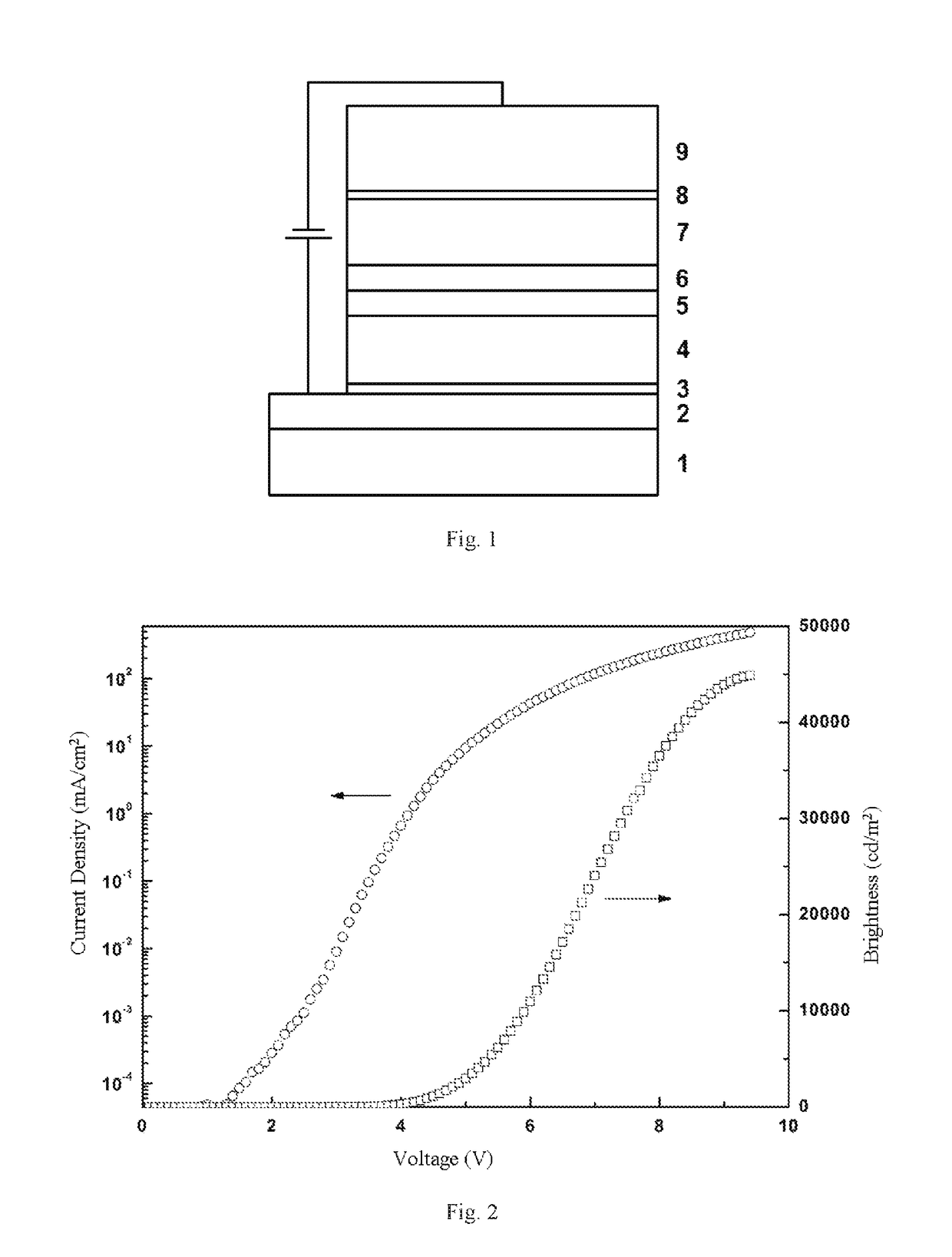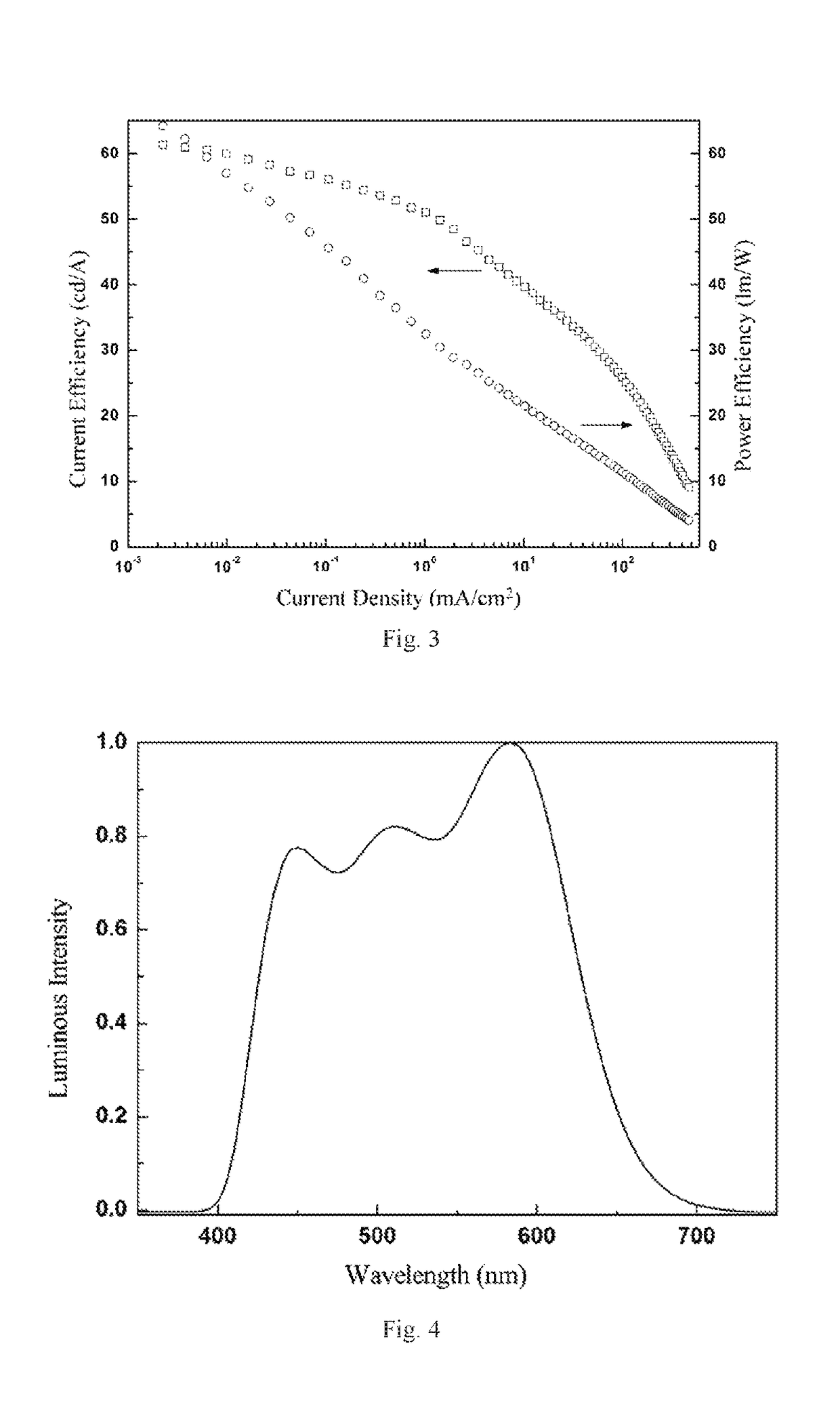White organic electroluminescent device and preparation method thereof
a technology of electroluminescent devices and white organic materials, which is applied in the direction of luminescent compositions, organic semiconductor devices, luminescent compositions, etc., can solve the problems of low efficiency and brightness of devices, relatively high working voltage, and high manufacturing cost of devices, so as to improve light-emitting effectiveness improve spectral stability of devices. , the effect of improving the light-emitting effect of organic electroluminescent devices
- Summary
- Abstract
- Description
- Claims
- Application Information
AI Technical Summary
Benefits of technology
Problems solved by technology
Method used
Image
Examples
example 1
[0092]An ITO anode layer on an ITO glass was laser-etched into a strip electrode, then ultrasonically cleaned sequentially with a cleaning liquid and deionized water for 15 min. and placed in an oven for drying. The dried substrate was then placed in a pretreating vacuum chamber, and the ITO anode was subjected to a low-pressure plasma treatment for 3 min under an atmosphere having a vacuum degree of 10 Pa with a voltage of 400V and then transferred to an organic evaporation plating chamber. In an organic evaporation plating chamber with a vacuum degree of 1-2×10−5 Pa, a MoO3 anode modification layer 3 having a thickness of 3 nm, a TAPC hole transporting-electron blocking layer 4 having a thickness of 40 nm, a TcTa hole-dominated light-emitting layer 5 doped with PQ2Ir(dpm) and Ir(ppy)3 having a thickness of 10 nm, a CzSi electron-dominated light-emitting layer 6 co-doped with Tm(acac)3phen and FCNIrpic having a thickness of 10 nm, and a TmPyPB hole blocking-electron transporting la...
example 2
[0096]An ITO anode layer on an ITO glass was laser-etched into a strip electrode, then ultrasonically cleaned sequentially with a cleaning liquid and deionized water for 15 min, and placed in an oven for drying. The dried substrate was then placed in a pretreating vacuum chamber, and the ITO anode was subjected to a low-pressure plasma treatment for 3 min under an atmosphere having a vacuum degree of 10 Pa with a voltage of 400V and then transferred to an organic evaporation plating chamber. In an organic evaporation plating chamber with a vacuum degree of 1-2×10−5 Pa, a MoO3 anode modification layer 3 having a thickness of 3 nm, a TAPC hole transporting-electron blocking layer 4 having a thickness of 40 nm, a mCP hole-dominated light-emitting layer 5 doped with PQ2Ir(dpm) and Ir(ppy)3 having a thickness of 10 nm, a CzSi electron-dominated light-emitting layer 6 co-doped with Tm(acac)3phen and FCNIrpic having a thickness of 10 nm, and a TmPyPB hole blocking-electron transporting lay...
example 3
[0098]An ITO anode layer on an ITO glass was laser-etched into a strip electrode, then ultrasonically cleaned sequentially with a cleaning liquid and deionized water for 15 min, and placed in an oven for drying. The dried substrate was then placed in a pretreating vacuum chamber, and the ITO anode was subjected to a low-pressure plasma treatment for 3 min under an atmosphere having a vacuum degree of 10 Pa with a voltage of 400V and then transferred to an organic evaporation plating chamber. In an organic evaporation plating chamber with a vacuum degree of 1-2×10−5 Pa, a MoO3 anode modification layer 3 having a thickness of 3 nm, a TAPC hole transporting-electron blocking layer 4 having a thickness of 40 nm, a TcTa hole-dominated light-emitting layer 5 doped with PQ2Ir(dpm) and Ir(ppv)3 having a thickness of 10 nm, a 26DCzPPy electron-dominated light-emitting layer 6 co-doped with Dy(acac)3 and FCNIrpic having a thickness of 10 nm, and a TmPyPB hole blocking-electron transporting la...
PUM
| Property | Measurement | Unit |
|---|---|---|
| thickness | aaaaa | aaaaa |
| thickness | aaaaa | aaaaa |
| thickness | aaaaa | aaaaa |
Abstract
Description
Claims
Application Information
 Login to view more
Login to view more - R&D Engineer
- R&D Manager
- IP Professional
- Industry Leading Data Capabilities
- Powerful AI technology
- Patent DNA Extraction
Browse by: Latest US Patents, China's latest patents, Technical Efficacy Thesaurus, Application Domain, Technology Topic.
© 2024 PatSnap. All rights reserved.Legal|Privacy policy|Modern Slavery Act Transparency Statement|Sitemap



